Properties of Gaze Strategies Based on Eye–Head Coordination in a Ball-Catching Task
Abstract
1. Introduction
2. Methods
2.1. Participants
2.2. Experimental Subject and Apparatus
2.3. Experimental Conditions and Procedure
2.4. Data Analysis
3. Results
3.1. Comparison of Catch Rates between Groups
3.2. Comparison of Upward Peak Head Velocity (UPHV) between Groups and Conditions
3.3. Comparison of Downward Peak Eye Velocity (DPEV) between Groups and Conditions
3.4. Relationship between Head and Eye Movements
3.5. Comparison of UPHV and DPEV between When Catching and Failing in Novices
4. Discussion
4.1. Catching Performance
4.2. Head Movements in Catching the Ball
4.3. Eye Movements in Catching the Ball
4.4. Relationship between Head and Eye Movements
5. Conclusions
Author Contributions
Funding
Institutional Review Board Statement
Informed Consent Statement
Data Availability Statement
Conflicts of Interest
References
- Nakamoto, H.; Fukuhara, K.; Torii, T.; Takamido, R.; Mann, D.L. Optimal integration of kinematic and ball-flight information when perceiving the speed of a moving ball. Front. Sports Act. Living 2022, 4, 930295. [Google Scholar] [CrossRef] [PubMed]
- Takamido, R.; Yokoyama, K.; Yamamoto, Y. Hitting movement patterns organized by different pitching movement speeds as advanced kinematic information. Hum. Mov. Sci. 2022, 81, 102908. [Google Scholar] [CrossRef] [PubMed]
- Meyer, J.; Smeeton, N.J.; Fasold, F.; Schul, K.; Schon, T.; Klatt, S. Shot deception in basketball: Gaze and anticipation strategy in defence. Hum. Mov. Sci. 2022, 84, 102975. [Google Scholar] [CrossRef] [PubMed]
- Regan, D. Visual factors in hitting and catching. J. Sports Sci. 1997, 15, 533–558. [Google Scholar] [CrossRef]
- Savelsbergh, G.J.; Whiting, H.T.; Pijpers, J.R.; van Santvoord, A.A. The visual guidance of catching. Exp. Brain Res. 1993, 93, 148–156. [Google Scholar] [CrossRef] [PubMed]
- Tresilian, J.R. Hitting a moving target: Perception and action in the timing of rapid interceptions. Percept. Psychophys. 2005, 67, 129–149. [Google Scholar] [CrossRef]
- Land, M.F.; McLeod, P. From eye movements to actions: How batsmen hit the ball. Nat. Neurosci. 2000, 3, 1340–1345. [Google Scholar] [CrossRef] [PubMed]
- Lopez-Moliner, J.; Brenner, E.; Louw, S.; Smeets, J.B. Catching a gently thrown ball. Exp. Brain Res. 2010, 206, 409–417. [Google Scholar] [CrossRef] [PubMed]
- Lopez-Moliner, J.; Brenner, E. Flexible timing of eye movements when catching a ball. J. Vis. 2016, 16, 13. [Google Scholar] [CrossRef]
- Freedman, E.G.; Sparks, D.L. Coordination of the eyes and head: Movement kinematics. Exp. Brain Res. 2000, 131, 22–32. [Google Scholar] [CrossRef]
- Roy, J.E.; Cullen, K.E. Brain stem pursuit pathways: Dissociating visual, vestibular, and proprioceptive inputs during combined eye-head gaze tracking. J. Neurophysiol. 2003, 90, 271–290. [Google Scholar] [CrossRef] [PubMed]
- Nakata, H.; Miura, A.; Yoshie, M.; Kudo, K. Differences in the head movement during baseball batting between skilled players and novices. J. Strength. Cond. Res. 2012, 26, 2632–2640. [Google Scholar] [CrossRef] [PubMed]
- Higuchi, T.; Nagami, T.; Nakata, H.; Kanosue, K. Head-eye movement of collegiate baseball batters during fastball hitting. PLoS ONE 2018, 13, e0200443. [Google Scholar] [CrossRef] [PubMed]
- Kimpo, R.R.; Rinaldi, J.M.; Kim, C.K.; Payne, H.L.; Raymond, J.L. Gating of neural error signals during motor learning. Elife 2014, 3, e02076. [Google Scholar] [CrossRef] [PubMed]
- Shinkai, R.; Ando, S.; Nonaka, Y.; Yoshimura, Y.; Kizuka, T.; Ono, S. Importance of head movements in gaze tracking during table tennis forehand stroke. Hum. Mov. Sci. 2023, 90, 103124. [Google Scholar] [CrossRef] [PubMed]
- Kishita, Y.; Ueda, H.; Kashino, M. Eye and Head Movements of Elite Baseball Players in Real Batting. Front. Sports Act. Living 2020, 2, 3. [Google Scholar] [CrossRef] [PubMed]
- Gonzalez, C.C.; Causer, J.; Grey, M.J.; Humphreys, G.W.; Miall, R.C.; Williams, A.M. Exploring the quiet eye in archery using field- and laboratory-based tasks. Exp. Brain Res. 2017, 235, 2843–2855. [Google Scholar] [CrossRef] [PubMed]
- Vickers, J.N. Visual control when aiming at a far target. J. Exp. Psychol. Hum. Percept. Perform. 1996, 22, 342–354. [Google Scholar] [CrossRef] [PubMed]
- Miles, C.A.; Wood, G.; Vine, S.J.; Vickers, J.N.; Wilson, M.R. Quiet eye training aids the long-term learning of throwing and catching in children: Preliminary evidence for a predictive control strategy. Eur. J. Sport. Sci. 2017, 17, 100–108. [Google Scholar] [CrossRef]
- Yoshimura, A.; Hosotani, Y.; Kimura, A.; Kanda, H.; Okita, Y.; Uema, Y.; Gomi, F. Quantitative evaluation of blinking in blepharospasm using electrooculogram-integrated smart eyeglasses. Sci. Rep. 2023, 13, 9868. [Google Scholar] [CrossRef]
- Zangemeister, W.H.; Jones, A.; Stark, L. Dynamics of head movement trajectories: Main sequence relationship. Exp. Neurol. 1981, 71, 76–91. [Google Scholar] [CrossRef] [PubMed]
- Fogt, N.; Persson, T.W. Vertical head and eye movements in baseball batting. Optom. Vis. Perform. 2020, 8, 129–134. [Google Scholar] [PubMed]
- Mann, D.L.; Nakamoto, H.; Logt, N.; Sikkink, L.; Brenner, E. Predictive eye movements when hitting a bouncing ball. J. Vis. 2019, 19, 28. [Google Scholar] [CrossRef] [PubMed]
- Parvinpour, S.; Shafizadeh, M.; Balali, M.; Abbasi, A.; Wheat, J.; Davids, K. Effects of Developmental Task Constraints on Kinematic Synergies during Catching in Children with Developmental Delays. J. Mot. Behav. 2020, 52, 527–543. [Google Scholar] [CrossRef] [PubMed]
- Wibble, T.; Pansell, T.; Grillner, S.; Perez-Fernandez, J. Conserved subcortical processing in visuo-vestibular gaze control. Nat. Commun. 2022, 13, 4699. [Google Scholar] [CrossRef] [PubMed]
- Shelhamer, M.; Tiliket, C.; Roberts, D.; Kramer, P.D.; Zee, D.S. Short-term vestibulo-ocular reflex adaptation in humans. II. Error signals. Exp. Brain Res. 1994, 100, 328–336. [Google Scholar] [CrossRef] [PubMed]
- Lisberger, S.G. Visual guidance of smooth-pursuit eye movements: Sensation, action, and what happens in between. Neuron 2010, 66, 477–491. [Google Scholar] [CrossRef] [PubMed]
- Ono, S.; Mustari, M.J. Response Properties of MST Parafoveal Neurons during Smooth Pursuit Adaptation. J. Neurophysiol. 2016, 116, 210–217. [Google Scholar] [CrossRef] [PubMed]
- Ono, S.; Mustari, M.J. Extraretinal signals in MSTd neurons related to volitional smooth pursuit. J. Neurophysiol. 2006, 96, 2819–2825. [Google Scholar] [CrossRef] [PubMed][Green Version]
- Mann, D.L.; Spratford, W.; Abernethy, B. The head tracks and gaze predicts: How the world’s best batters hit a ball. PLoS ONE 2013, 8, e58289. [Google Scholar] [CrossRef] [PubMed]
- Mann, D.L.; Fortin-Guichard, D.; Nakamoto, H. Review: Sport Performance and the Two-visual-system Hypothesis of Vision: Two Pathways but Still Many Questions. Optom. Vis. Sci. 2021, 98, 696–703. [Google Scholar] [CrossRef]
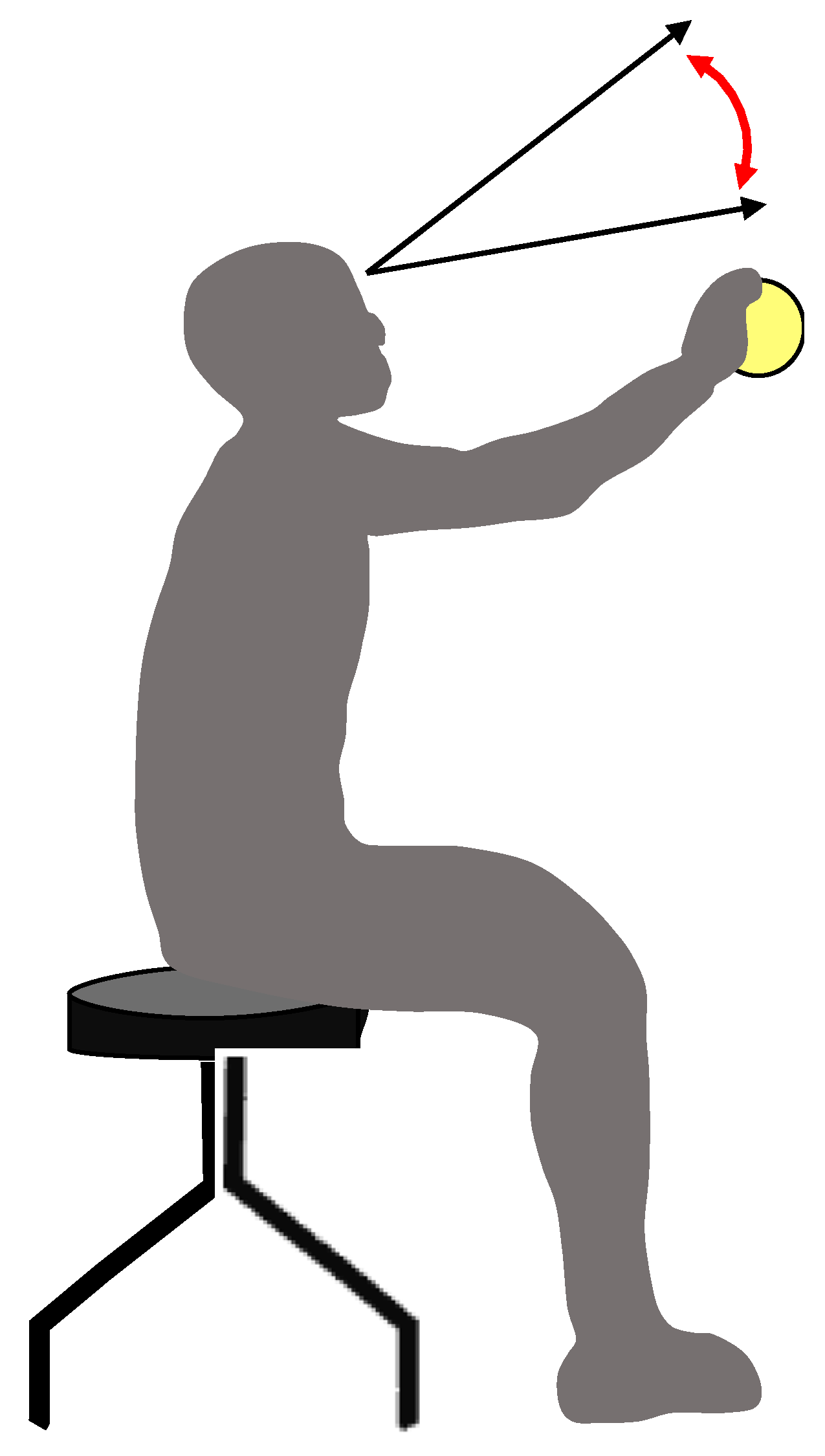
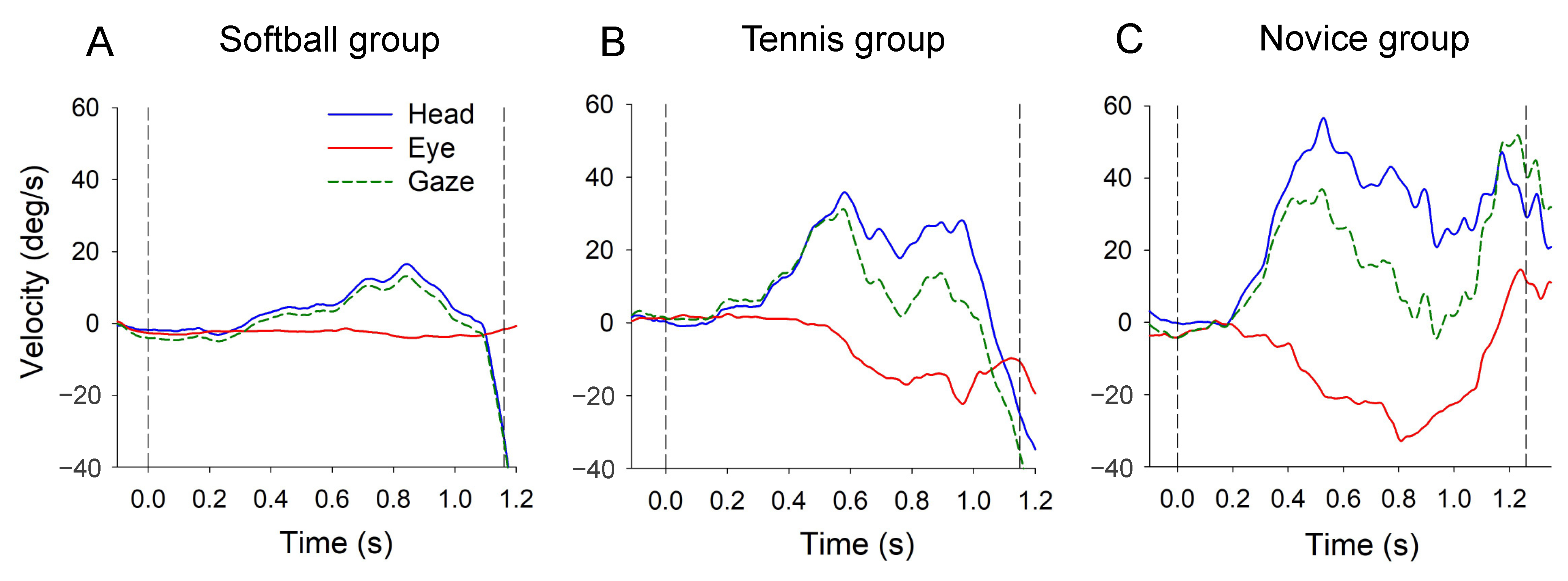
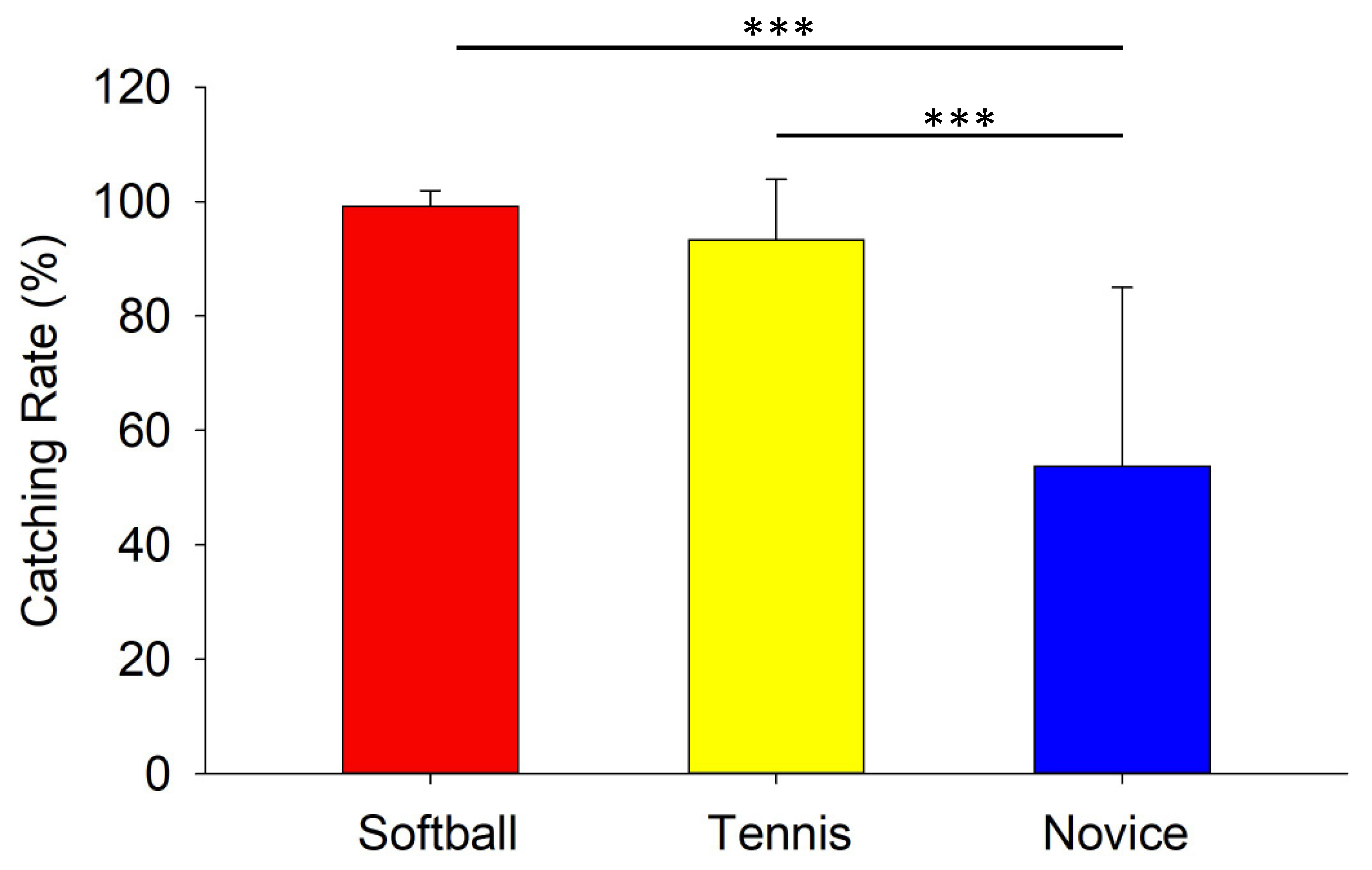
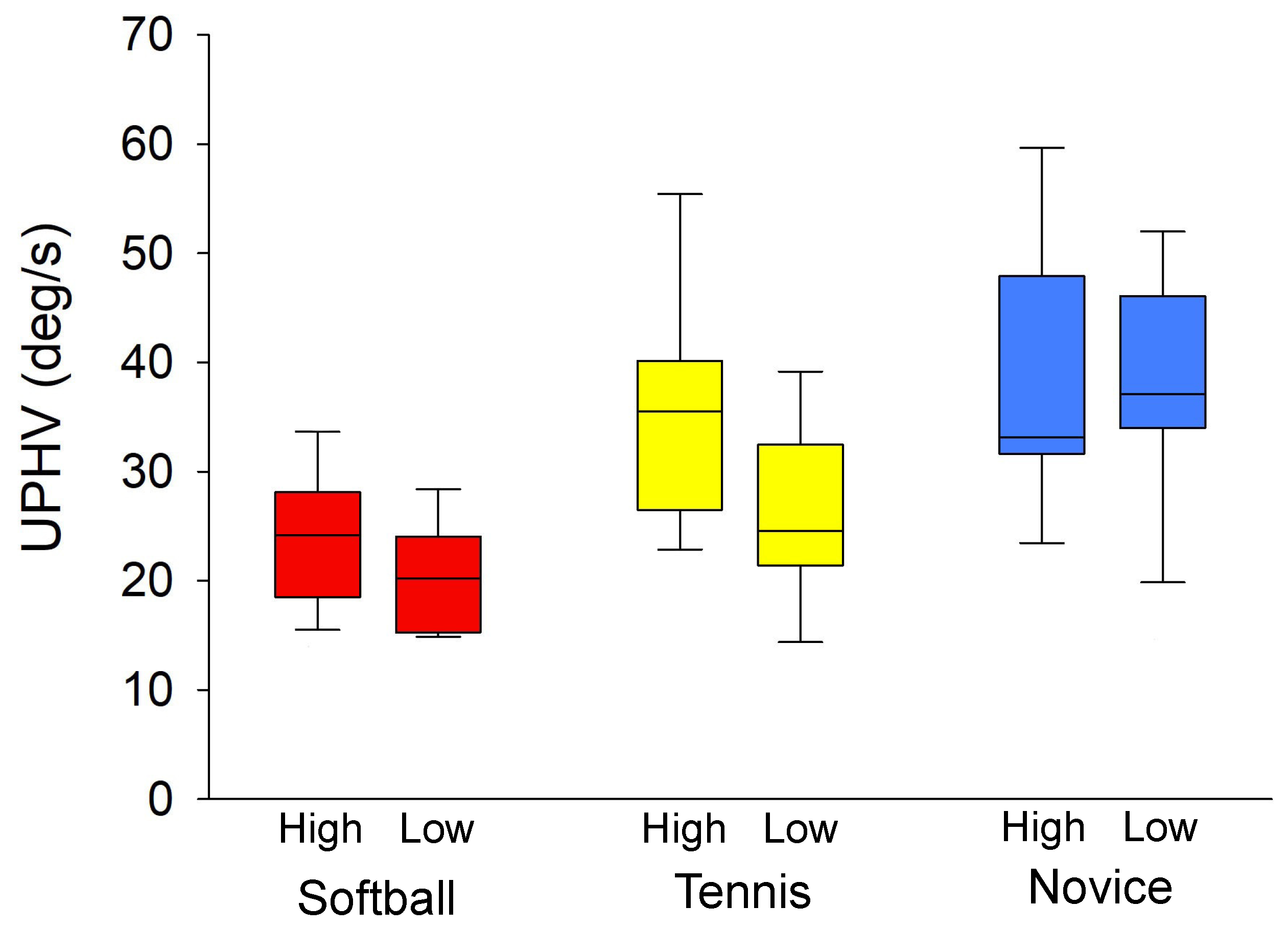
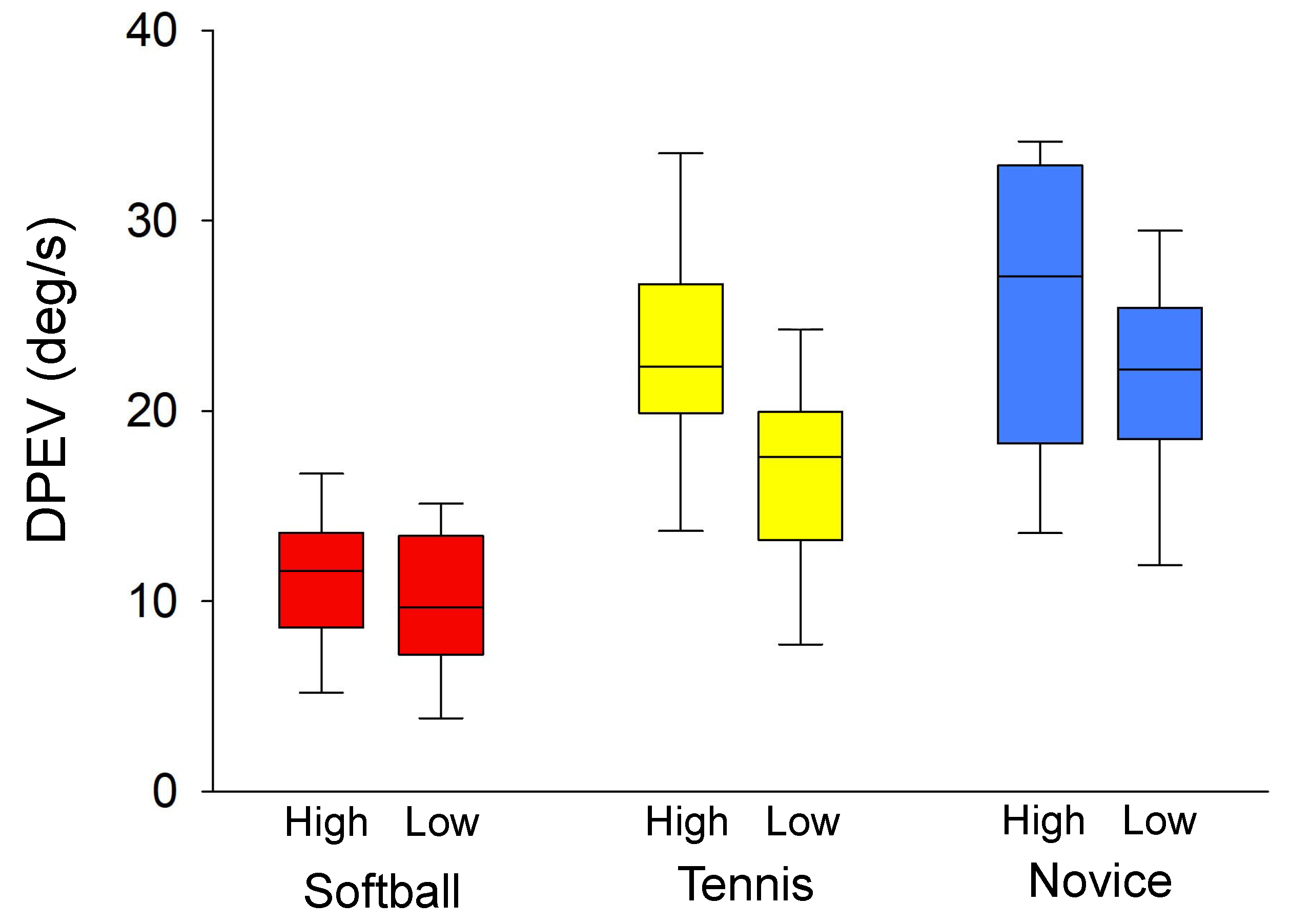
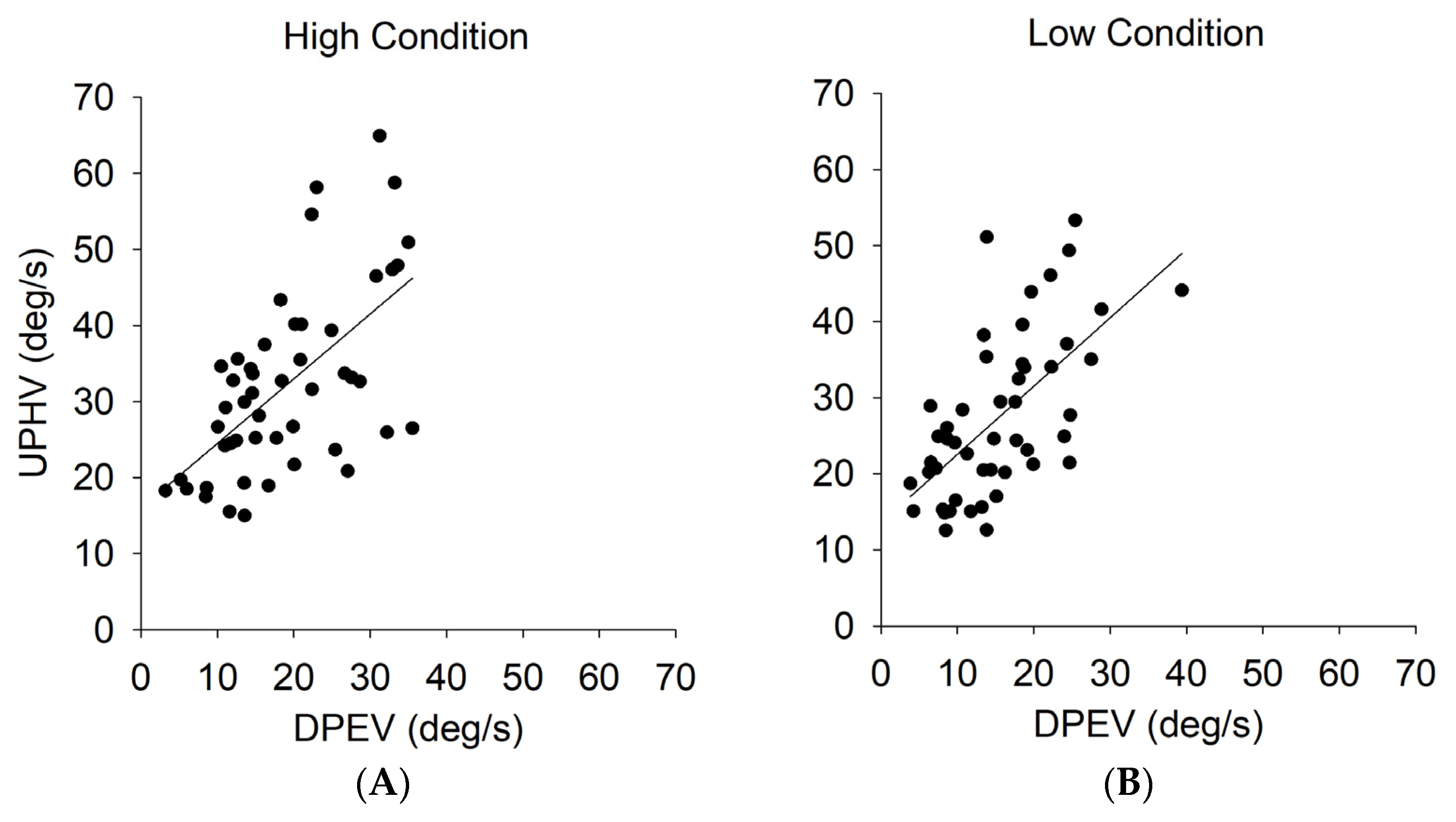
Disclaimer/Publisher’s Note: The statements, opinions and data contained in all publications are solely those of the individual author(s) and contributor(s) and not of MDPI and/or the editor(s). MDPI and/or the editor(s) disclaim responsibility for any injury to people or property resulting from any ideas, methods, instructions or products referred to in the content. |
© 2024 by the authors. Licensee MDPI, Basel, Switzerland. This article is an open access article distributed under the terms and conditions of the Creative Commons Attribution (CC BY) license (https://creativecommons.org/licenses/by/4.0/).
Share and Cite
Ono, S.; Yoshimura, Y.; Shinkai, R.; Kizuka, T. Properties of Gaze Strategies Based on Eye–Head Coordination in a Ball-Catching Task. Vision 2024, 8, 20. https://doi.org/10.3390/vision8020020
Ono S, Yoshimura Y, Shinkai R, Kizuka T. Properties of Gaze Strategies Based on Eye–Head Coordination in a Ball-Catching Task. Vision. 2024; 8(2):20. https://doi.org/10.3390/vision8020020
Chicago/Turabian StyleOno, Seiji, Yusei Yoshimura, Ryosuke Shinkai, and Tomohiro Kizuka. 2024. "Properties of Gaze Strategies Based on Eye–Head Coordination in a Ball-Catching Task" Vision 8, no. 2: 20. https://doi.org/10.3390/vision8020020
APA StyleOno, S., Yoshimura, Y., Shinkai, R., & Kizuka, T. (2024). Properties of Gaze Strategies Based on Eye–Head Coordination in a Ball-Catching Task. Vision, 8(2), 20. https://doi.org/10.3390/vision8020020




